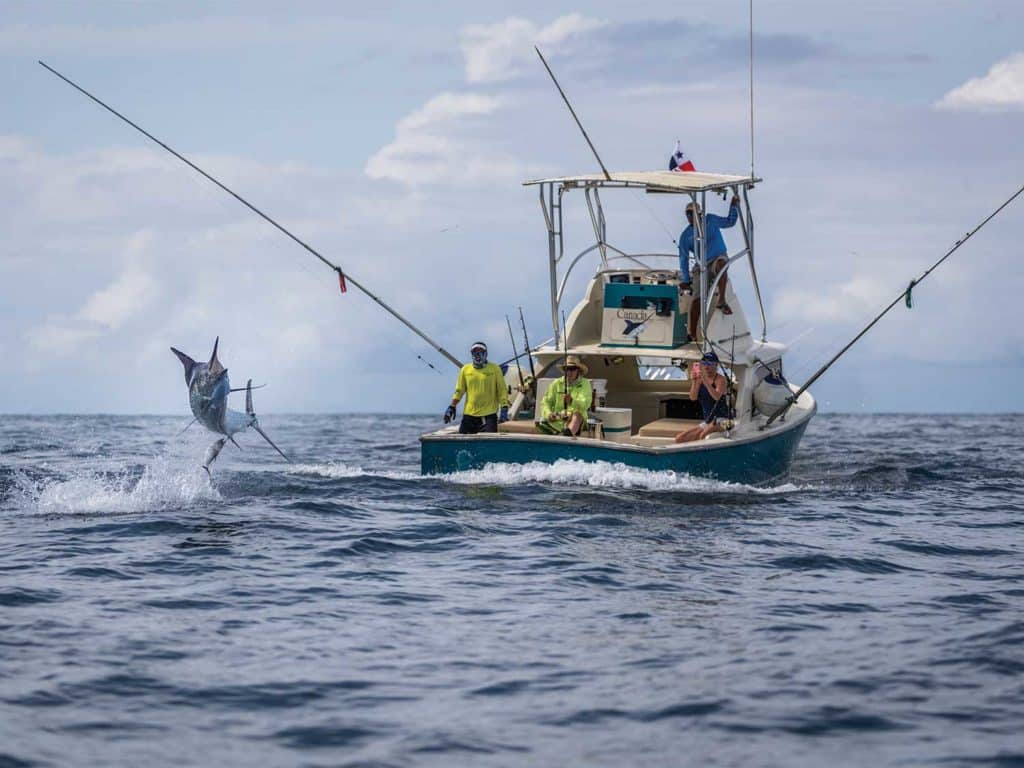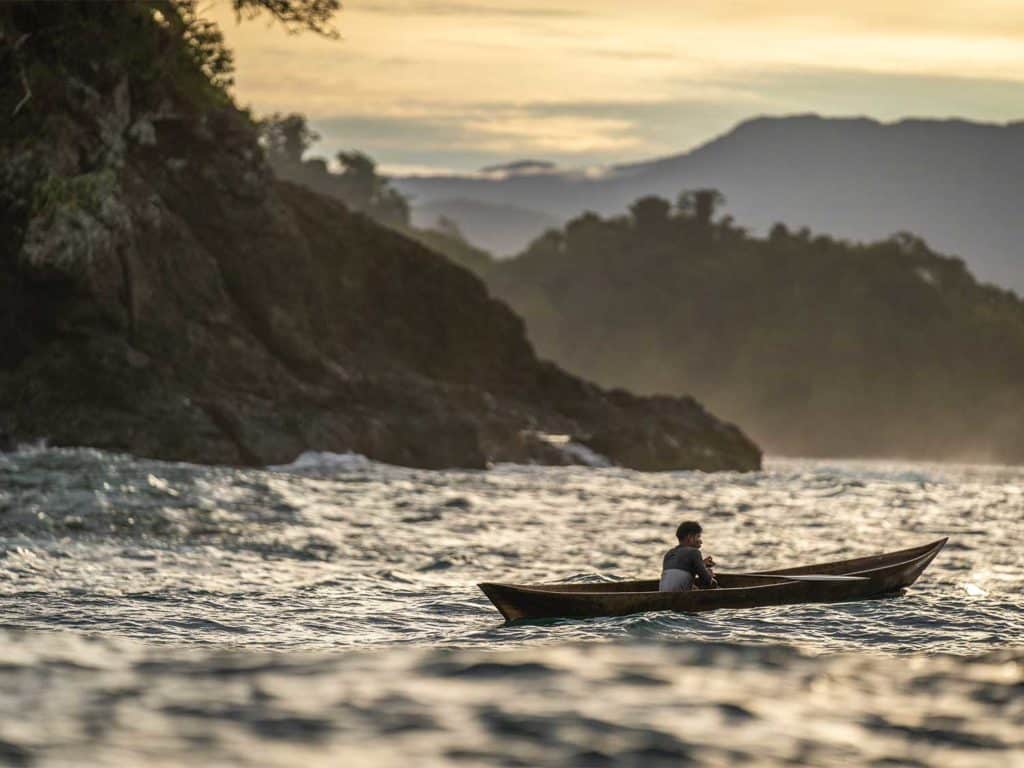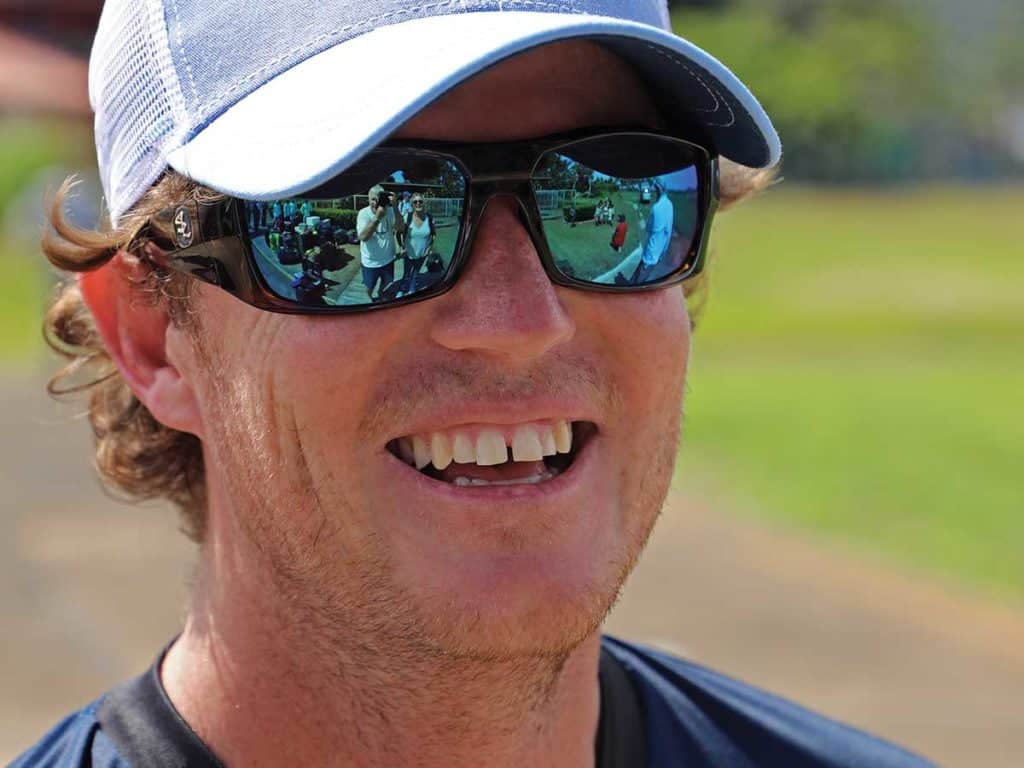
Special delivery: Sign up for the free Marlin email newsletter. Subscribe to Marlin magazine and get a year of highly collectible, keepsake editions – plus access to the digital edition and archives.
The imagery coming out of Panama is outrageous these days. Two artists are capturing photographs of the country that are indeed bold, unusual and breathtaking, and for all the best reasons. Born in Sweden, Hannes Ribbner and Matilda Leijon have not only changed the way we see Panama’s fishery, but they’ve also managed to carve out a creative niche that has tangibly altered what we ever thought possible when it comes to billfish photography.
Even the best photographers in the sport-fishing industry are recognized with a signature—a unique style that distinguishes their works from others. Similar to the cadence you might recognize in a close friend’s voice, their images are instantly familiar, and Ribbner and Leijon undoubtedly have such signatures. Whether ornamenting the pages of Marlin or populating your Instagram feed, their photos stand out with jaw-dropping depth of field, creative use of background, and tack-sharp detail.
Jungle Rules
Ribbner was the first to follow his lens to Panama, even though the introduction to billfish photography occurred long before that—several thousand miles away. While working as a captain and mate in Madeira, Cape Verde, Bom Bom and Ascension Islands, Ribbner attempted to take photographs of jumping billfish while working in the cockpit or on the bridge. “Some people can—and I did—get a few nice shots here and there,” he explains, “but I found out that if you do not focus 100 percent on either photography or fishing, most of the time you end up with terrible photos and a lost fish. In 2018, I decided that I wanted to try to make billfish photography a professional career, so I bought myself a really good camera setup. I eventually sent a text to my friend Capt. Zak Conde in Cape Verde, and we agreed that I could spend a couple of months with him to build up a portfolio. The fact that my camera survived is a miracle.”

While Ribbner was building his portfolio in some trying seas, the images captured the attention of Capt. Jen Copeland, the senior editor at Marlin. Since then, Ribbner’s talents have resulted in several cover shots and countless featured photographs in the magazine. Copeland could always rely on him to produce the kinds of photos that keep readers coming back for more—ones that allow billfish to breach right from the sea and into our very souls—and she felt that there was more to come for the ambitious photographer. “Jen asked me what I wanted to do looking forward, and I had this idea that I could stay at a lodge and shoot for the clients,” Ribbner recalls, “and after some thought she said, ‘Well, then you need to go to Tropic Star!’”
Tropic Star Lodge is located in Piñas Bay, Panama, some 150 miles south of Panama City. The premier outfitter is blissfully removed from the hustle of city streets, in the Darien Jungle, and offers anglers an incomparable world-class fishing experience. Depending on the time of year, guests can expect fantastic inshore and offshore opportunities; black marlin, blue marlin, sailfish, yellowfin tuna, roosterfish, dorado, and a variety of snapper and grouper species make for regular targets.
Read Next: Learn more about Tropic Star Lodge here.
After Copeland introduced the proposal to TSL’s fishing director, Richard White, Ribbner signed on as an independent contractor offering photography services to the lodge’s guests. “Panama has a lot to offer,” Ribbner says, “and the staff at Tropic Star Lodge really does emphasize all of its best attributes. Many people make friends for life down here, and the place is also absolutely beautiful, especially in the southwest. We are over 100 miles from the nearest road, and it is virtually untouched.”
Tropic Star’s welcoming atmosphere, close access to the fishing grounds, and typically calm seas are ideal for both anglers and photographers alike. “The famous Zane Grey Reef is only 5 miles from Piñas Bay, so during black marlin season, we’ll be fishing 15 minutes after we’ve left the dock. We have to go a bit farther to catch blues, but we never have to run for more than an hour.”

TSL boasts a large fleet of colorful 31-foot Bertrams, which are not only set up for great angling, but are also an excellent platform for Ribbner’s work. “I love the small Bertrams for shooting because I can really get low, and the cockpit is huge,” he says. “In some photos, it literally looks like I am shooting in the water. Sometimes you can snap a good photo from the bridge, but other than that, that vantage point doesn’t look very special to me, especially if you prefer a tight frame. I think it is because you get only two elements in the shot: the water and a fish.”
It’s no question that Ribbner’s photos are dynamic, often going well beyond just those two elements. He prefers images that share a narrative, and there is much to extract from the unique details he manages to capture. “If you shoot low, you will get the horizon, maybe a jungle backdrop; sometimes birds, porpoises, rainstorms and all kinds of cool stuff are in there, which makes the picture about a lot more than just the fish,” he says. “It tells you a story.”
Ribbner has spent almost 10 months of each of the past two years living his dream, and the guests are more than happy to see their own dreams fulfilled, which keeps the talented photographer busy. “Tropic Star has between 30 and 45 guests fishing on up to 16 boats every week, so it’s a great opportunity for me to get booked almost every day,” Ribbner explains. “The lodge gets unfettered access to the pictures for their social media, website and any other marketing needs, so I take pictures not only of jumping billfish, but also of the guests enjoying their time on the boat. I’m not a portrait photographer by any stretch, but I do enjoy taking pictures of people, especially when they are on the fish of their dreams. You can’t fake those facial expressions, and I think those photos feel—and are—very authentic.”

Enter Matilda
As Ribbner remained busy day after day, it became clear that there would be more than enough room for another full-time photographer to join in, and there was only one person Ribbner had in mind for the job.
A little under a decade ago, Ribbner attended a sport-fishing show in Stockholm, Sweden. It was there that he met an extremely talented force in the industry named Matilda Leijon. Leijon had grown up ice-fishing with her father, a special experience that quickly turned into a lifelong passion. “In high school I studied fishing tourism, nature and water,” she says. “We learned a lot about the anatomy of fish, fishing methods, and how to conserve and protect the natural world. I was the fourth girl to graduate from this fishing academy.”
When Leijon first laid eyes on Ribbner, it didn’t take long for her to fall for him. The two had an instant connection, although it took some time for them to make it official. As many couples in this industry know well, distance is challenging, especially with limited communication in remote locations. “When I first saw Hannes, he was this long-haired, bearded guy with a very relaxed aura, and I fell in love the very second he flashed me that first smile,” Leijon says. “The time and place weren’t right for us back then; we needed five years of adventures on our own until we realized that life is way more fun together.”
In those five years, Leijon remained busy with her own work. She filmed and edited popular YouTube fishing shows. Eventually she started her own company, just as the COVID-19 pandemic swept the globe. She lost 80 percent of her clients due to the shutdowns, but she took a summer job in a tackle shop to help make ends meet. Leijon and Ribbner finally became an official couple, but he was far away in Panama.

Months later, Leijon’s business skyrocketed as folks were ready to get back to work. The filmmaker soon found herself drowning in deadlines. “I hadn’t seen the sun in a month due to the pouring rain, and I was working my ass off,” she says. “Hannes would send me some colorful photos late at night, and I just wanted to pull the pillow over my head. These late-night check-ins repeated themselves for several months—I had to catch up with work, and Hannes got to see marlin every day, eating fresh sashimi on the boat while I had instant ramen.”
When it rains, it pours—but in this case, it was for the better. By the time Ribbner returned to Sweden, he had a proposition for Leijon. “When he came back to Sweden in March, he told me I just had to see the place,” Leijon says. “I rolled my eyes at him, explaining how well everything was going for me now that business was up and running again. He said: ‘Matilda, please. I don’t want to be away from you four months straight again.’”
It took about the same amount of time for Leijon to fall in love with Panama as it did for her to fall in love with Ribbner, and she couldn’t pass up the opportunity to work with him at Tropic Star. “We shoot all day, compare photos in the afternoon, complain about blue marlin jumping too far away for a photo, and give each other high-fives when we get the cover shot of Marlin,” Ribbner says with a smile. “It would not have been easy to do this without her.”

On-the-Job Training
Ribbner and Leijon are certainly different, but they also complement each other both personally and professionally. They even describe each other with immeasurable warmth and appreciation. “Hannes is a very easygoing person,” Leijon says. “He gets along with everyone he meets. He’s my biggest fan and supports me in everything, whether it’s photography, cooking, working out, fishing, or life. I wish everyone had a Hannes in their life—they’d have so much fun if they did.”
“Matilda is probably the most extroverted introvert I have ever met,” Ribbner says with a grin. “She thinks she’s not a people person, but if you ask anyone she’s ever met, they would tell you that is a big fat lie. I also think that is why she does so well here. Everyone who she has fished with and taken photos for has been grateful, and really enjoyed having her on the boat.”
Shortly after Leijon took the job at TSL, Ribbner shared some crucial tips with her for photographing billfish. Their collaborative relationship is inspiring, especially because they are also competitors. I’m not even comfortable letting my husband touch my computer, and you can bet it all that I certainly wouldn’t share any trade-writing secrets with him. But Leijon and Ribbner’s magic is proven amid the catapulting marlin and sailfish captured in their photography.

Ribbner helped Leijon at the onset, but he insists that her talents are of her own making. “I did train her, in a way, but most of it she did herself,” he says. “It took me more than a season to figure out how I wanted my camera settings set up. That only comes from trying, failing, trying again, succeeding, but feeling something is off, and then carrying on like that every day for months. The shooting part is what I think takes the longest to learn though, and that was what I was worried about. If you haven’t seen many marlin or dorado before, it is very hard to predict where they are going to be at a certain time. Add a telephoto lens at 400mm, and it is like tracking an exotic sports car that moves erratically and goes into stealth mode for seconds at a time. When you are trying to frame the fish super-tight at a really large aperture with a super-narrow depth of field, it gets difficult. Autofocus has improved a lot over the past few years, but even now, if you are not pre-focused pretty close to where the fish is going to jump, the autofocus will not have time to adjust. This is where I was the most impressed with and proud of her. She picked up this part quickly, and today, Matilda gets as many shots in focus as I do, and she doesn’t even have a background in marlin fishing. To me, that is extremely impressive.”
Ribbner and Leijon get these shots all while keeping in mind that they are fishing with clients. The duo has mastered how best to document the day without being in the way. “Because we spend 10 hours with two to four guests on a 31-foot boat every day, we have to know where to be—and where not to be,” Ribbner explains. “We have to know when to interact and when to go hide. We want to be a part of their experience but also take up as little space as possible. There is a fine line between being nice and interfering with their family time. All guests are different too, so adapting to the situation is vital. You must be able to read the room.”
Ribbner also takes great pride in what he’s been able to achieve with his career in Panama. “I am so proud that I have built this idea of photographing guests to document their fishing holidays myself,” he says. “People such as Jen Copeland, Richard White, [Tropic Star CEO] Ursula Marais and Zak Conde, just to mention a few, have all helped me make this happen. Almost everyone wants to show family and friends pictures from their holiday, and this is why so many returning guests book me every day of their trip: They want to just put away their phones and be able to enjoy the fishing.”

Leijon and Ribbner have made wonderful friends and found family in Piñas Bay, but they still miss their loved ones back in Sweden. Even when the challenges of jungle Wi-Fi and near-nonexistent cell service threaten to keep communications at a minimum, the pair seem incredibly happy with their station at Tropic Star Lodge. They’re proud of what they’ve been able to accomplish—individually and collectively. “I literally screamed out loud when I got my first cover of Marlin,” Leijon says with a laugh. “I ran to Hannes in the kitchen and showed him the photo. I don’t know if it was the onions or his feelings that overwhelmed him, but in the eyes of my very supportive boyfriend, I saw tears.”
After chatting with these two, I can see why they work so well together, both as professional photographers and as a happy couple. Ribbner is the laid-back guy with long hair walking barefoot down the beach—quiet but friendly and observant. And Leijon is the stunning character who brings warmth, joy and laughter into every exchange, making hundreds of friends along the ride. Together, they are a pleasant and positive force in the world, a force that has yielded some of the most beautiful and compelling photographs the sport-fishing industry has ever seen. Their work has undoubtedly turned attention toward Panama, and has showcased the outrageously beautiful fishery found off its coast.







